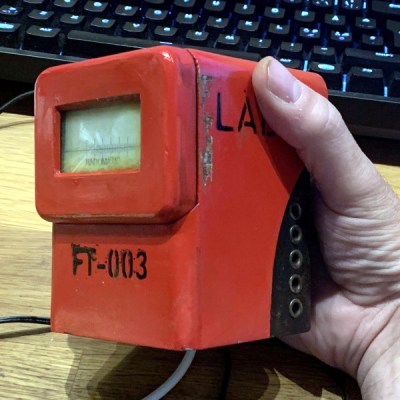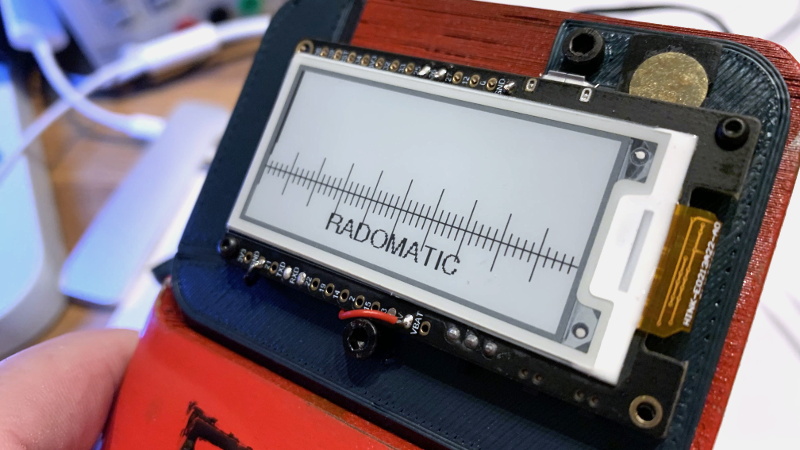While the full steampunk aesthetic might be a bit much for most people, those antique gauges do have a certain charm about them. Unfortunately, implementing them on a modern project can be somewhat tricky. Even if you’ve got a stock of old gauges laying around, you’ve still got to modify the scale markings and figure out how to drive them with digital electronics. While we’ve seen plenty of people do it over the years, there’s no debating it’s a lot harder than just wiring up an I2C display.
But maybe it doesn’t have to be. With his Rad-O-Matic, [Hans Jørgen Grimstad] created a pretty convincing “analog” gauge using a small e-ink panel. Of course it won’t fool anyone who gives it a close look, but at a glance, you could certainly be forgiven for thinking it was some kind of vintage indicator. Especially with the cracked and stained Fresnel lens he put in front of it.
 For this project [Hans] used a LilyGo T5, which combines an ESP32 with a 2.13 inch electronic paper display. These are presumably meant to be development boards for digital signage applications, but they occasionally show up in hacker projects since they’re so easy to work with. The board pulls data from a RD200M radon sensor over a simple UART connection, and the current reading is indicated by a “needle” that moves across a horizontal scale on the display.
For this project [Hans] used a LilyGo T5, which combines an ESP32 with a 2.13 inch electronic paper display. These are presumably meant to be development boards for digital signage applications, but they occasionally show up in hacker projects since they’re so easy to work with. The board pulls data from a RD200M radon sensor over a simple UART connection, and the current reading is indicated by a “needle” that moves across a horizontal scale on the display.
On its own, it wouldn’t look very vintage. In fact, quite the opposite. But [Hans] really helped sell the look on this project by designing and 3D printing a chunky enclosure and then weathering it to make it look like it’s been kicking around since the Cold War.
If you don’t feel like faking it, we’ve seen some very impressive projects based on authentic vintage gauges. As long as you don’t mind tearing up hardware that’s likely older than you are, putting in the extra effort necessary for a convincing modification can really pay off.
[Thanks to Tarjei for the tip.]
















[Independent to the content of this blog entry]
Do blog posts change their order now? I feel i have seen this a few days ago already and am confused. Also because i cannot find the old entry at the moment.
The thing is, when I start reading the blog (every few days), I go back to older posts until I see an entry I remember, assuming I have come past all new entries. If entries are pushed up again / or copied or presented very simillarly though, this will make me miss entries. I wonder how much I have not seen now.
If there’s no comments complaining about the post not being a hack, you can rest assured that it is new.
No, posts are always listed chronologically.
What about using analogue needle gauge and replacing background with e-ink, so you can swap the scale at will? Imagine having analogue multimeter, which switches the e-ink scale upon switch between Current and Voltage measurements? Or even autoranging analogue multimeter!
I was thinking the opposite (I think?).
Using e-ink displays to replace broken analog movements in old equipment.
I have an old IBM multimeter that has a bad D’Arsonval(sp?) movement. A web search did not turn up any replacements. It looks neat, but at the current price of e-inks it is not worth the effort to substitute on that one.
The opposite could also be a fixed needle and a moving e-ink display.
I love this idea!!!
Steampunk?
More like PipBoypunk!
B^)
Nice work!
In the second photo, I thought the display looked like it was “backlit” with a green LED, or the display “glass” was edge lit. But, I guess it was just ambient light reflecting off of the “glass”.
Do the holes on the side perform any function? (cooling?)
Vintage in quotes. There was Sperry and a few linear bar or needle displays then but almost all had an arc from a pivoting point scale, or edge on on a bulging face. All steam gauges for sure. It’s messier to write curves and worse to see jagged curved lines though.
What about video of that… artefact? :)